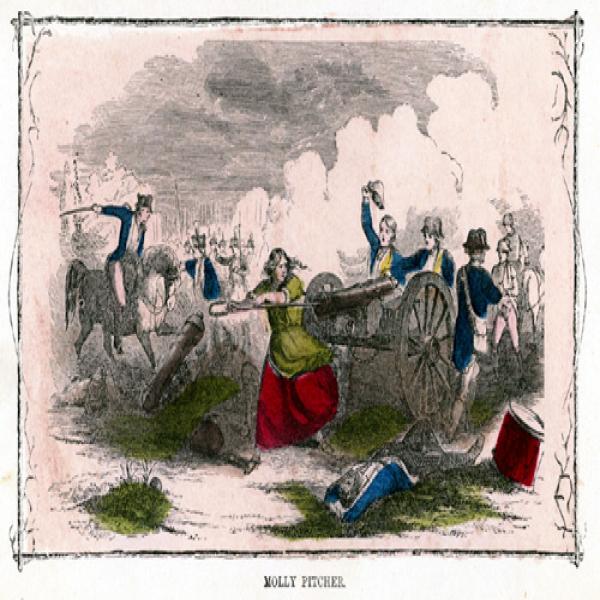Molly Pitcher
Original

Background Notes
The early history of the legendary American heroine, Molly Pitcher (ca. 1754-1832), including her birthplace and parents, relies upon unconfirmed evidence. The only undisputed fact is her first name, Mary. According to historian John B. Landis, she was born near Trenton, New Jersey, the daughter of a German-born dairyman named John George Ludwig, and was employed as a domestic servant before her first marriage. These claims cannot be verified, as they are based on oral testimony. Landis also claims, based on family testimony, that Mary married John (or John Casper) Hays, a barber from Carlisle, Pennsylvania. However, a 1989 study by D.W. Thompson and Mary Lou Schaumann asserts that post-1783 court records prove her husband's first name was William. All evidence taken into consideration, Mary probably did marry John Hays of Carlisle in 1769, producing one son, John L. Hays (1780-1856). Mary accompanied her husband who had joined the Continental Army, and it was at the June 28, 1778 Battle of Monmouth in New Jersey where she was immortalized as a heroine of the Revolutionary War. According to those who knew her in later years, Mary reminisced that the battle took place on a hot day, and that she carried buckets of water from a nearby creek to the thirsty troops, thus earning her the nickname "Molly Pitcher." Mary reportedly took her husband's place as a canon-loader when he fell wounded. It is a fact that John Hays served as an artillery gunner from December 1775 to December 1776; William Hays apparently held the same position starting in May 1777. Although scholars agree that Mary was present at Monmouth, there are no contemporary accounts of the battle confirming her specific acts of heroism.
After serving in the war, Mary and her severely injured husband returned to Carlisle, where the latter passed away in 1786. Soon thereafter she married John McCauley. Once again a widow around 1808 she earned a meager living mostly as a maid. The Pennsylvania legislature awarded her a yearly annuity of $40 in 1822 for her "services during the Revolutionary War." Her acquaintances described her as a woman of German ancestry, rather coarse yet honest, friendly, and hardworking. When Mary Hays McCauley died in Carlisle in 1832, local newspapers. obituaries gave no mention of her actions at Monmouth, and no grave marker was even erected for her burial. By the time of the centennial of the Revolution, her story was being renewed but at the same time entangled with the definitive accounts of Margaret Corbin's helping fire a cannon at the Battle of Fort Washington in November 1776. In 1876 a Carlisle group, with public sentiment mounting at the local 4th of July celebration, officially erected a headstone memorial to Mary as "The Heroine of Monmouth." A life-size statue of "Molly" was erected in Carlisle in 1916, as well as a bas-relief panel on the Monmouth battlefield monument depicting her as a powerful woman stuffing the ramrod into the cannon. An image of the heroic Molly Pitcher loading the cannon was also used as war propaganda by the artist C.W. Miller, in 1944. This was in the form of a poster, trying to draw women into the war effort and inspire patriotism in general. It is quite likely that Mary McCauley was indeed at the Battle of Monmouth, but her actions themselves, just like her early years, cannot be firmly documented. This image, engraved around 1854 by Baker & Andrew, a Boston Engraving firm, depicts "Molly" performing the act of bravery that she is most famous for; assisting in the continued operation of the cannon in the midst of battle. This engraving was based on a painting by John Chapin (1823- after 1907), who was known for his depictions of battle scenes. It is hand colored and shows John (or William) Hays lying wounded on the ground near his wife and the other Continental soldiers in charge of the battery. (1)
"Molly Pitcher," American National Biography, vol. 17 (NY: Oxford, 1999) 564-65.